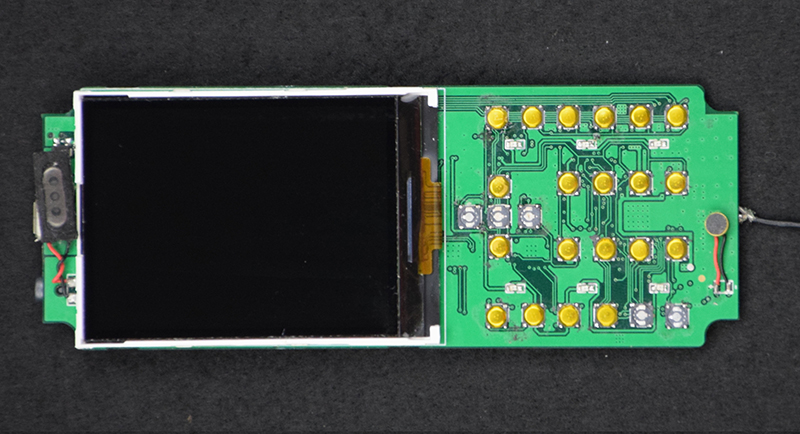Over the years, we’ve seen dozens of projects that sell themselves as an ‘Open Source’ cellphone, a hackable cellphone, or some other confabulation of a microcontroller, screen, and a cellular module. The WiPhone is not one of these projects. That’s not to say it’s not an Open Source phone that’s intended to be hackable. No, this is a DIY phone that doesn’t make cellular calls, because this is a phone that only works with SIP and VoIP apps. It’s a WiPhone, and something a lot of us have been waiting for.
The hardware for this WiFi enabled phone is extremely minimal, but there are some interesting tricks up its sleeve. Instead of letting the main microcontroller handle capturing all the button presses, the team behind the WiPhone are using a SN7326 key-scan controller. This cheap part is able to scan 64 buttons, although there are only 25 buttons on the phone. The audio board is a WM8750BL, a cheap codec with a stereo microphone interface and a 400 mW speaker driver. The display is a simple SPI TFT, and apart from the microcontroller, that’s about it.
But it’s the microcontroller that makes it, and for that we turn to the incredible ESP-32. This chip has enough power to play Doom, be a Game Boy, and in this case, make and receive calls from a VoIP provider, scan and connect to WiFi networks, and yes, it can even play snake.
While this is just about the simplest phone you can imagine, and it only works where there’s a WiFi network, a device like this could be invaluable. And really, these days how far are you from a WiFi network you’re already connected to anyway?















Sounds like you could get some nokia 5100/6100 handsets and degut and regut them with this.
We’ve designed mechanical parts for the WiPhone as well, just need to take more pictures and document them. The end goal is a real phone real people can use.
I’d love to see a diy phone using thick milled stainless as a chassis. water- and “bullet”proof!
Police shot a man today after the culprit beat the office with in an inch of his life with a stainless steel phone.
DECT would have battery life. But WiFi is getting there.
Yeah but on wifi you can deauth when your in laws are taking too long on the phone.
Does it have a speakerphone mode?
Any chance you can add a button on the side that can be used as a push to talk button?
There are 4 buttons reserved for user functions, though they are on the front and not the side.
We probably have a few solid months left getting the core functionality working well, but nothing is preventing a speakerphone mode from being added after that. Actually, it would probably be a pretty easy one for anyone to add later, since it’s an open platform. The present speaker is probably a little weak, but we are going to try to resolve that in the next board.
It would be a neat addition because then these could also be used as a wifi network two way radio, in addition to a phone.
The board may also lend itself to codec2 applications, as a hand held microphone doing real time low bit rate codec2 encode/decode like the open hardware rowetel SM1000,
I.e. http://www.rowetel.com/?page_id=3902
Is it really “Open Source” before the source is released? Did I just show up late, and the source ran out?
The ESP-32 source is the interesting part of the “open” idea, IMO.
Looks like it’s “open source” in the same way as facetime…
Where is the source code? I can’t find it! Please tell me it’s not some Open Source washing project.
To use a WiFi phone to make calls do you need to subscribe to a VOIP service?
If so which services are available?
Depends on what you need. If you need to call arbitrary numbers on the traditional phone system, yes, you’ll need to subscribe to a service to connect you to them. They generally cost money, but not as much money as a mobile or home line.
Free alternative (among other methods): Make accounts at sip2sip.info and install CSipSimple on the Android phone you need to call.
Can the CPU handle TLS/srtp? Without encryption I’d be uncomfortable broadcasting my conversations across the internet
Yeah anyone who has about thirty minutes to launch a website and backend service can now be your carrier
Lol, funny thing… Just saw this on tindie:
https://www.tindie.com/products/mg/1337-3310-wifi-an-esp32-inside-a-nokia-3310/
Two esp phone the same day..
I think HaD covered that one about a month ago…
Benis
I’ve wanted to make an ESP32 walkie talkie for a while. Something like Mumble, but where the server handles mixing all the tracks together. Right now unlicensed radios really, really suck. Cheap FRS radios make annoying beeps, that batteries barely work, and the range isn’t great.
This project could actually be useful to a lot of people.
Now combine this with another Hackaday favorite and put it in a pocket watch case.
Nixies?
B^)
LoRa radio anyone? Peer to peer up to 10km range…. should be good for skinny voice and messages. Just need to do something about that SIP dependency. It’s not got any privacy and needs the internet with a service. Is there a simpler way?